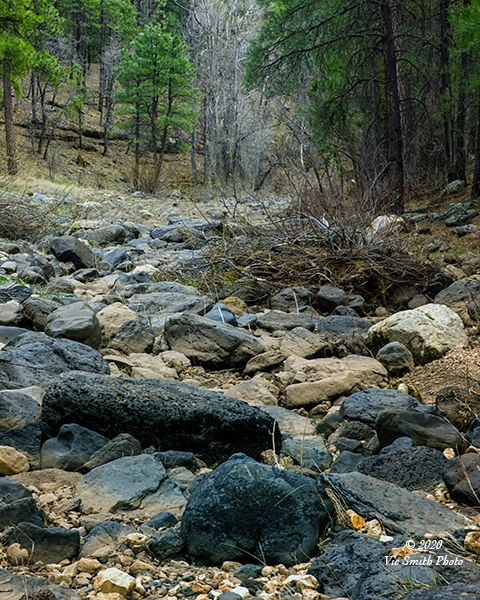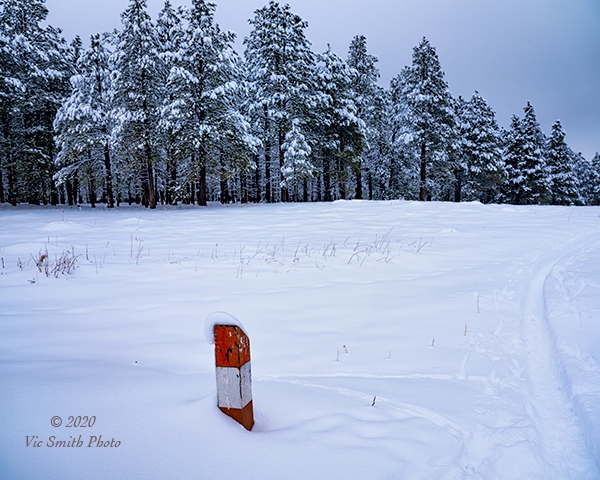I look forward to the quiet roar of winter snow on my land. The subtle crunch of frozen pine needles under the first falling energizes me. As powder rises toward our average 100 inches, I eagerly strap on snowshoes and go to a nearby meadow, balancing on buried logs and hills, and pretending I’m John Colter in Yellowstone. Winter work begins: relearning the delicate art of walking and driving on snow, slush, and ice, clearing the driveway and patio, scraping windshields, and removing roof ice.
All this I do willingly. In return, I get a tall pine forest. But I don’t get the magic of creeks. My snow is reclusive, a vagabond, following its own rules. It melts, finds fissures and cavities in the ground, and disappears, down toward an aquifer. Or it melts and runs down through canyons. It reappears in creeks and I must go there to witness my water flowing.
My land is high, an island of moisture risen over southwestern aridity, a land of sometimes water over a land of much less water. My snow builds slowly, but can then disappear quickly in a surprise spring rainstorm, headed down toward aridity.
Sometimes the water comes in a whoosh, during the unpredictable summer monsoon. Dark rain cells bring thunder, lightning and dump their cargo frighteningly hard, faster than the ground can absorb it. A flood gathers and then barrels down along earthly contours as gravity demands. Rocks and boulders, sand, mud, trees are overcome, pushed out of the way and down the channel. The water appears in a flash, often by surprise, and then recedes. What is left is a dry wide meandering break in the vegetation of bushes and trees, filled with rocks and debris, too much water suddenly bulldozing new paths.
Not far from my snow land are large channels carved by whooshes and then fed by my snow. These places convey to me the power and unpredictability of water, and its unrelenting abeyance to the earthly forces that bring it and then send it down its courses.
When I travel south, I can pass over bridges that span two such channels. One is Pumphouse Wash, a normally dry canyon that feeds into the upper end of the well known Oak Creek Canyon. Further on is a second one, a flatter channel with large sycamore and cottonwood trees and short willow thickets, their bases wrapped with plant and grass detritus point in the direction of a hard flow. This is called Dry Beaver Creek.
I’ve gone to this creek when it flowed, stood on a ledge and watched my former snow. It had come down a canyon, found just the right course, entered this sometimes flood path and made the dry creek flow. Birds flitted about and highway tourists stopped to watch. The mountain water, now turned brown from the soft sandstones and mudstones along its path, was hypnotic. Its froth and foam overcame rocks and chewed at the restraining sandy banks. I knew that the snow would melt and this miracle would flow for just a bit and then again go dry. I knew that the trees would gather the vitality and power of the sometimes water, leaf out, and enjoy another summer. I enjoyed the drama.
This is beautiful country, colorful mesas and mountains under big skies filled with vibrant clouds. My pines are tall with the undergrowth mostly limited to grasses and short bushes. Native people who’ve lived on this land know that its water is scarce, its flow is magic, and its preservation is crucial. Some carve the roots of the cottonwood tree, knowing that it grows tall where it finds water, and use those carvings in ceremonies to coax water from their unpredictable skies for their corn, beans, squash, and chile fields. They’ve done so for millenia.
I have another land as well, also with snow but with different waters: the northern Rocky Mountains. My path takes me over a bridge with the Bitterroot River flowing beneath it ( Lewis and Clark followed it in 1805 after being saved from starvation by the Bitterroot Salish people). It is fed from the 200+ in of snow that falls on the Bitterroot Range to the west and the Anaconda Range to the south, always moving toward the mighty Columbia River.
A small park that gives access to the bank of the Bitterroot. Rain has hastened the melt of the snowy cover of the Mountains and sending it into roaring creeks that feed the river. Its clear water comes from hard rock sources, and is mostly calm and flat, except for riffles and small whitecaps from standing waves that mark underwater obstacles like rocks and stumps. Submerged shoreline grasses and tree trunks line the edges. The day’s flow is seasonally high, 2500 cfs, not a flood. (Flows five times larger happened before the dam built near the Bitterroot crest was built in the 1940’s.)
My little alcove is a driveup window at river level through which I can stand among dense tall trees and thick undergrowth. I watch and listen to the flow wash by, hypnotized by its riffles and relentless rhythms. An orange-breasted robin joins me on a tree branch up and off to right, sheltering. A morning rain squall floats above and makes things even wetter. A duck surfs by, riding a momentary riffle. Dark logs and branches peek up and slide past, small gators chasing the duck.
The flow of the Bitterroot seems normal. Snow comes and then melts. Creeks flow and join a river. People go to the creeks and the river. They gather the abundant water, live on it, feed the garden, feed the lawn and their crops, spraying it out in relentless pulsing fusillades filling the air with evaporation and the ground with dense moisture.
Water is a miracle. It was created only once, during the heat and pressure present at the formation of the earth. And like all earthly entities, it follows the earth’s rules where it finds itself, as commanded, sinking into, rolling over, going around any quixotic bodies it encounters. It comes and goes where it will when it will. Earthly life responds to those results, adapting to survive. It is mandatory, alluring, powerful, elusive, and often controversial (consider the aphorism: whiskey’s for drinking, water’s for fighting).
Water may seem eternal. But that’s an illusion. The earth changes, always. Movement of the earth’s axis has made the Sahara Desert wet or dry on a 20,000 year cycle. Today, because of our fossil fuel addictions, our climate is changing 10 times faster than any time since the dinosaurs died, 65 million years ago. (Mea culpa: my drive north is a part of such addictions.) These changes are lessening moisture and increasing temperatures, enabling ominous futures for much of the world’s water and food supply.
After all this, I am a child of my lands, all of them, from the arid to the well watered. Both lands make me feel small and humble. Plentiful moisture brings enlivening green growth that towers over and wraps me up, making me rise up with it. But sometimes that greenery can become too dense to me, like being in a closet. Then I long for the wide open lands of abundant scarcity, the red, brown, yellow of oxidized iron in rocks and the occasional green of rugged trees, bushes, and grasses. Water will always be a mystery to me, to be treasured, coaxed, and shared with all life.
**please contact me (vic at vicsmithphoto.com) if you are interested in reviewing it
My thanks to Jessie, Rich, and Wayne for help
V6 (7/7/20)







